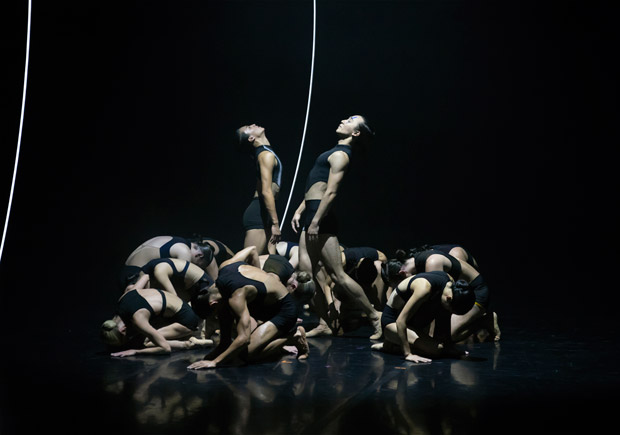
© Emma Kauldhar. (Click image for larger version)
Northern Ballet
Mixed Programme: The Kingdom of Back, Mamela…, The Shape of Sound
★★★★✰
Leeds, Stanley & Audrey Burton Theatre
12 September 2018
northernballet.com
Good to see Northern Ballet (NB) presenting another triple bill and even better that all the pieces were brand new commissions. That’s actually a rarer thing in UK ballet than you’d hope and full chops to David Nixon and Mark Skipper for making it happen. The ‘big’ number on the bill was from NB resident choreographer Kenneth Tindall, presenting his first new piece for the company since the critically-acclaimed blockbuster that was Casanova. But my eye was also very much drawn to Morgann Runacre-Temple who I’ve been tracking for years and is maturing into a very confident and reliable creator of dramatic work and should be more widely known. Also on the bill was Mlindi Kulashe, a dancer (first soloist) with the company for 5 years and this was his first commission. So a good night for Leeds coupling a rising star from outside with local and much-loved company talent.
At a time when the focus is on female dance makers getting a fair share of ballet and dance creative action, Morgann Runacre-Temple also reminded us why – they are drawn to different stories and perspectives. Her piece, The Kingdom of Back, was about Mozart’s older and lesser-known sister, Nannerl, and her relationship with Wolfgang and their dominating father, Leopold. Runacre-Temple can deftly tell a narrative plot, but here she was less clear and more about the moods, motivations and the arc of the characters over time. What I love about Morgann’s work is the quirky way she shows character in movement, at times abandoning any conventional dance language – like Kenneth MacMillan she can make inner turmoil physical. The quirkiness was also reflected in an outsize wig for Nannerl, that seemed to represent the weight of her talent and all the pressures from those around her. Four and a half years older than Wolfgang Mozart, she played at a professional level, duetted with her brother, also composed and yet none of her work survives and as she came to marriageable age was forced to give it all up as her younger brother grew in stature. You see the change in power but dominating all, as in life, is the harsh father – he broods, pushes and sternly prompts his offspring to ever greater achievements.

© Emma Kauldhar. (Click image for larger version)
The three main characters were danced by Antionette Brooks-Daw, Javier Torres (Leopold) and Milindi Kulashe (Wolfgang) and the first two drew you in to their driven world. I was less convinced by Wolfgang, but that’s maybe because this was not about him and his incredible talent – he was meant to recede? Besides the dramatic choreography for the three protagonists, there were occasional free-flowing sections, often involving four other couples, amplifying emotions. A masterstroke was to involve Frank Moon in pulling together the sound collage which included sections of narrated text from Mozart family letters, and music ranging from the Swingle Singers all through to David Bowie. This gave an ever-shifting, pacey and eclectic backdrop to a polished work. It’s a keeper and a piece that you could find more in each time.
After dancing one of the lead roles in Kingdom of Back, Mlindi Kulashe then had to quickly get out front for the premiere of his first work – Mamela…. No-matter how sincerely expressed I’m never sure about pieces where the choreographer says it’s up to you to construct your own narrative. It seems a cop-out to me and as a response I generally find myself feeling I’ve been watching a confused and unfocussed work. Not a view universally shared, I know. It’s also a harsh view on a work that was better than that might suggest.

© Emma Kauldhar. (Click image for larger version)
Mamela… is based on exploring “…the conflict between the head and the heart…”. and for sure you could pick up on togetherness and alienation etc as the 9 dancers shifted around in anonymous, unisex grey costumes. But I didn’t feel intrigued or drawn-in despite the mysterious dark sound score, by Jack Edmunds, including muttered voices and emotion-laden strings. But what of the choreography? Well it was fine enough. Kulashe is no angry young man tearing up the rule-book (and either wowing or making us terminally depressed) but a creator of clear contemporary movement, if not yet particularly distinctive. I thought it worked best when he animated all nine dancers and filled the stage, which is not always so easily done. It was an assured first work – he clearly deserved the commission, and he delivered a piece that complimented the other works on the bill. I hope he gets more small commissions and develops an unmistakable tone.
The Shape of Sound is Kenneth Tindall’s piece to Max Richter’s take on Vivaldi’s The Four Seasons. It’s an abstract work with the aim of challenging himself to expand his range of steps. It’s good music for that, with a span from the moodily intimate to the big and very bold and the 15 dancers attacked every phrase with gusto. Tindall has the common touch and this was effortlessly accessible excitement that made the dancers sparkle. There were some nice duets but overall it was sections for the whole cast that had the stage pulsing with contemporary energy.
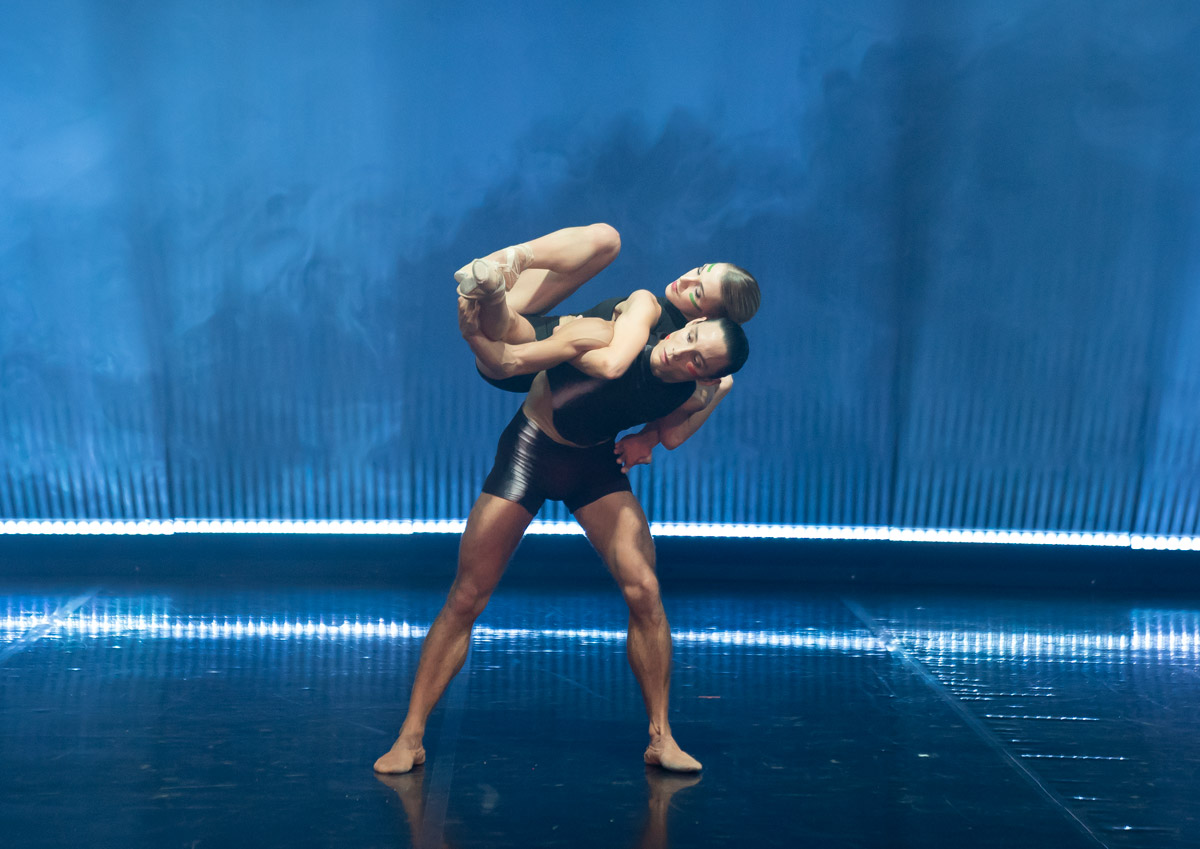
© Emma Kauldhar. (Click image for larger version)
The masterstroke in The Shape of Sound was the lighting rig – amazingly ambitious for a 230-seat studio theatre. Tindall’s full job title (besides resident choreographer) starts “Artistic Director of Digital” and that showed in the clever digital lighting by him and Alastair West and its adroit integration into the action. Like Matthew Bourne Tindall is a confident provider of steps but is much more about the integration of all the elements into a notable and classy theatrical experience. It’s an uplifting work and score that sends us home buzzing about the physicality of dance and dancers – it certainly deserves to be seen on larger stages. Tindall is on a roll.










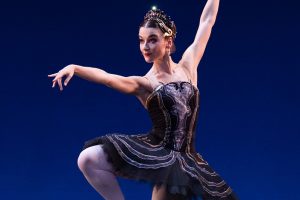

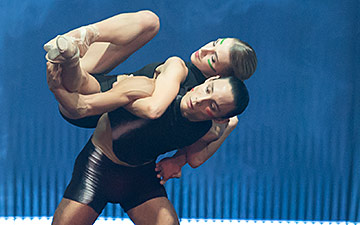
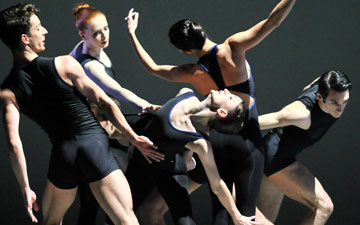
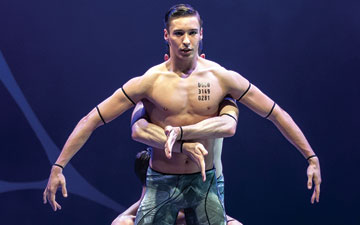


Isn’t Northern Ballet the realm of Yoko Ishino? More about her, please.
Nothing particular to say about Yoko Ichino, other then she has a senior role as rehearsal director of the company and associate director of the NB Academy. There is more about her on these links:
https://northernballet.com/biography/yoko-ichino
https://northernballet.com/academy/the-ichino-technique